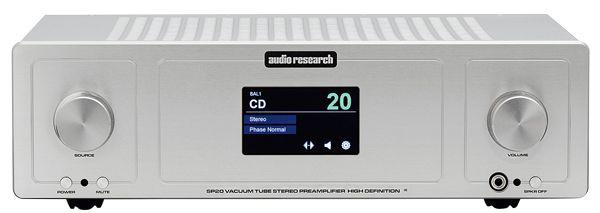Audio Research Sp20 (£8998)

Suffice it to say, gone are the days of a half-dozen toggle switches, mechanical push-buttons or old-school rotaries. The SP20’s buttons are limited to power on, mute and a choice of output to ‘speakers’ (power amp) or headphones, but not at once. The optically-coupled rotaries provide level and source, everything else is adjusted via the touchscreen. And a beautifully-made metal remote covers all bar the most rarely used subsidiary functions.
Comprehensive in more ways than even the feature-laden touchscreen menus imply, the SP20 is perfect for 2014, as it also addresses the current twin revivals of headphones and the LP.
The former – addressed for the first time ever in an Audio Research preamp – is accessed via a ¼in socket on the front panel and offers plenty of power. The onboard phono stage is quiet enough, musical enough and fine-tuneable enough to preclude any hunger for an outboard unit, while at the back are the RIAA phono input plus earthing post, four single-ended line-level inputs, two balanced XLR inputs, separate monitor-in and record-out for recordists, and two pairs of balanced outputs. There is also an RS-232 port, IR-input, 12V trigger and a 15A IEC connector.
A tube-hybrid, the SP20 contains four valves within – a pair of 6H30s for phono stage duties and another for the line stage. After 4000 hours of use the ‘Settings’ icon glows red indicating the need for re-tubing.
The only disconcerting element, which would soon lapse with familiarity, is the odd feel of the speed-sensitive rotary controls relative to conventional types. You’ll soon get the hang of holding the source rotary one way or the other, awaiting a click of the relays.
Family likeness
It was instantly apparent that the ARC SP20 bore much of the prowess of the REF 5SE (£2.5k more). You will know immediately that this is the successor to a long and distinguished line of ARC preamplifiers.
Its SP20 headphone output allowed us to hear even more in the 24-bit Beatles transfers from the USB-stick-inside-an-apple, these the most information-rich versions available, we think. That’s not to say they’re necessarily the best nor most lifelike, just the most detail-heavy and revealing of any system’s retrieval capabilities.
The tonal colours in ‘While My Guitar Gently Weeps’ were rendered with such presence that any music shop habitué would not only identify the make of guitar but possibly the brands of strings and plectra as well.
Shimmering again occurred with the lush opening track of Nancy Wilson’s All In Love Is Fair [SoulMusic], ‘You’re As Right As Rain’. Her voice is uncharacteristically fragile, backed by angelic singers, with enough strings to redefine ‘saccharine’. The SP20 presented a perfectly seamless panorama that filled the room.
In spite of its CD origins, the most remarkable aspect was the sweet treble, slightly less cloying than through our REF 5SE, though the latter possesses a more powerful low end. Blessedly, however, the SP20 is as sibilance-free as its all-tube elder sister.
It is an incredible preamplifier. Turning to an epic like Wheatus’s raucous, majestic ‘Teenage Dirtbag’ from the band’s eponymous debut [Columbia], the wall of guitars that hits at 00m 40s demonstrates the physics of Phil Spector’s ‘Wall of Sound’ despite not being mono, and not involving a phalanx of musicians. Through the SP20, it utterly rocks.
Verdict
Having experienced over a dozen Audio Research preamps, our initial concern was addressed post-haste: the SP20 acts exactly as a modern ARC control unit should. It is detailed, open, musical, expressive and commanding. It suffers no lack of facilities. And we confess the headphone amp and touchscreen become seductive adjuncts.
Originally published in the 2014 Yearbook























































